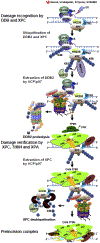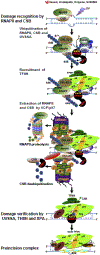Timely upstream events regulating nucleotide excision repair by ubiquitin-proteasome system: ubiquitin guides the way
- PMID: 33991872
- PMCID: PMC8206018
- DOI: 10.1016/j.dnarep.2021.103128
Timely upstream events regulating nucleotide excision repair by ubiquitin-proteasome system: ubiquitin guides the way
Abstract
The ubiquitin-proteasome system (UPS) plays crucial roles in regulation of multiple DNA repair pathways, including nucleotide excision repair (NER), which eliminates a broad variety of helix-distorting DNA lesions that can otherwise cause deleterious mutations and genomic instability. In mammalian NER, DNA damage sensors, DDB and XPC acting in global genomic NER (GG-NER), and, CSB and RNAPII acting in transcription-coupled NER (TC-NER) sub-pathways, undergo an array of post-translational ubiquitination at the DNA lesion sites. Accumulating evidence indicates that ubiquitination orchestrates the productive assembly of NER preincision complex by driving well-timed compositional changes in DNA damage-assembled sensor complexes. Conversely, the deubiquitination is also intimately involved in regulating the damage sensing aftermath, via removal of degradative ubiquitin modification on XPC and CSB to prevent their proteolysis for the factor recycling. This review summaries the relevant research efforts and latest findings in our understanding of ubiquitin-mediated regulation of NER and active participation by new regulators of NER, e.g., Cullin-Ring ubiquitin ligases (CRLs), ubiquitin-specific proteases (USPs) and ubiquitin-dependent segregase, valosin-containing protein (VCP)/p97. We project hypothetical step-by-step models in which VCP/p97-mediated timely extraction of damage sensors is integral to overall productive NER. The USPs and proteasome subtly counteract in fine-tuning the vital stability and function of NER damage sensors.
Keywords: Nucleotide excision repair; Ultraviolet radiation; deubiquitination; ubiquitination.
Copyright © 2021 Elsevier B.V. All rights reserved.
Conflict of interest statement
Authors statement
Authors do not have any conflicts to declare.
Conflict of interest
All authors have no an actual or perceived conflict of interest with the contents of this article.
Figures


Similar articles
-
Nucleotide Excision Repair: Finely Tuned Molecular Orchestra of Early Pre-incision Events.Photochem Photobiol. 2017 Jan;93(1):166-177. doi: 10.1111/php.12647. Epub 2016 Nov 17. Photochem Photobiol. 2017. PMID: 27696486 Free PMC article. Review.
-
UV-induced proteolysis of RNA polymerase II is mediated by VCP/p97 segregase and timely orchestration by Cockayne syndrome B protein.Oncotarget. 2017 Feb 14;8(7):11004-11019. doi: 10.18632/oncotarget.14205. Oncotarget. 2017. PMID: 28036256 Free PMC article.
-
Valosin-containing Protein (VCP)/p97 Segregase Mediates Proteolytic Processing of Cockayne Syndrome Group B (CSB) in Damaged Chromatin.J Biol Chem. 2016 Apr 1;291(14):7396-408. doi: 10.1074/jbc.M115.705350. Epub 2016 Jan 29. J Biol Chem. 2016. PMID: 26826127 Free PMC article.
-
Ubiquitin-specific protease 7 regulates nucleotide excision repair through deubiquitinating XPC protein and preventing XPC protein from undergoing ultraviolet light-induced and VCP/p97 protein-regulated proteolysis.J Biol Chem. 2014 Sep 26;289(39):27278-27289. doi: 10.1074/jbc.M114.589812. Epub 2014 Aug 12. J Biol Chem. 2014. PMID: 25118285 Free PMC article.
-
The emerging role of deubiquitination in nucleotide excision repair.DNA Repair (Amst). 2016 Aug;44:118-122. doi: 10.1016/j.dnarep.2016.05.035. Epub 2016 Jun 2. DNA Repair (Amst). 2016. PMID: 27316462 Free PMC article. Review.
Cited by
-
DNA Damage-Induced RNAPII Degradation and Its Consequences in Gene Expression.Genes (Basel). 2022 Oct 26;13(11):1951. doi: 10.3390/genes13111951. Genes (Basel). 2022. PMID: 36360188 Free PMC article. Review.
-
SUMO-Activating Enzyme Subunit 1 Is Associated with Poor Prognosis, Tumor Progression, and Radio-Resistance in Colorectal Cancer.Curr Issues Mol Biol. 2023 Sep 30;45(10):8013-8026. doi: 10.3390/cimb45100506. Curr Issues Mol Biol. 2023. PMID: 37886949 Free PMC article.
-
NEIL3-mediated proteasomal degradation facilitates the repair of cisplatin-induced DNA damage in human cells.Sci Rep. 2023 Mar 30;13(1):5174. doi: 10.1038/s41598-023-32186-3. Sci Rep. 2023. PMID: 36997601 Free PMC article.
-
BTG3-dependent VCP/p97 nuclear translocation is required for efficient repair of UV-induced DNA lesions.Nucleic Acids Res. 2025 Jul 8;53(13):gkaf626. doi: 10.1093/nar/gkaf626. Nucleic Acids Res. 2025. PMID: 40626560 Free PMC article.
-
Xeroderma Pigmentosum Complementation Group C (XPC): Emerging Roles in Non-Dermatologic Malignancies.Front Oncol. 2022 Apr 21;12:846965. doi: 10.3389/fonc.2022.846965. eCollection 2022. Front Oncol. 2022. PMID: 35530314 Free PMC article. Review.
References
-
- Glickman MH, Ciechanover A. The ubiquitin-proteasome proteolytic pathway: destruction for the sake of construction, Physiol Rev. 82 (2002) 373–428. - PubMed
-
- Varshavsky A. The ubiquitin system, Trends Biochem. Sci 22 (1997) 383–387. - PubMed
-
- Groll M, Bajorek M, Kohler A, Moroder L, Rubin DM, Huber R, Glickman MH, Finley D. A gated channel into the proteasome core particle, Nat. Struct. Biol 7 (2000) 1062–1067. - PubMed
-
- Kisselev AF, Akopian TN, Castillo V, Goldberg AL. Proteasome active sites allosterically regulate each other, suggesting a cyclical bite-chew mechanism for protein breakdown, Mol. Cell 4 (1999) 395–402. - PubMed
Publication types
MeSH terms
Substances
Grants and funding
LinkOut - more resources
Full Text Sources
Other Literature Sources
Miscellaneous

